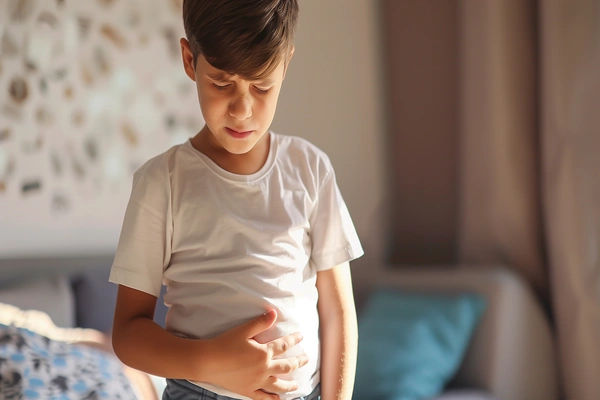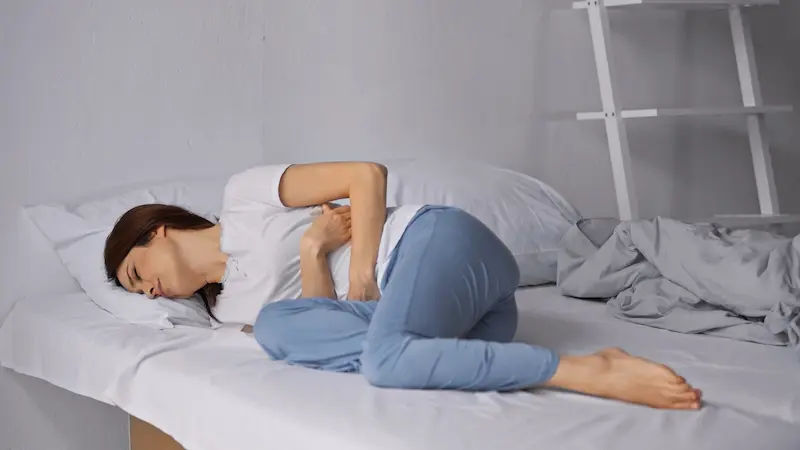Guide to Acute Abdominal Pain
Suffering from sudden, severe abdominal pain? Our guide breaks down the common causes, symptoms, and when to seek urgent medical care for acute abdominal pain. Get informed now.


Introduction
A sudden, sharp twinge in your belly can be alarming. Acute abdominal pain—discomfort that comes on quickly and lasts hours to a few days—has many possible causes. Some are mild and pass with rest and fluids. Others, like appendicitis or gallstones, need prompt medical care. Knowing which is which can save time, anxiety, and sometimes lives.
This guide walks you through what acute abdominal pain means, when it’s an emergency, and which causes are most likely based on location and triggers. You’ll learn how doctors figure out the diagnosis, what tests are used, what you can safely do at home, and how common conditions are treated. We’ll cover special considerations for children, older adults, and pregnancy, and share practical tips to reduce recurrences. Along the way, you’ll find real-world examples, evidence-based advice, and a clear path to care—whether that’s a teleconsult or an ER visit. If symptoms persist or worsen, you can consult a doctor online with Apollo24|7 for further evaluation and next steps.
What Counts as “Acute Abdominal Pain”?
- Acute abdominal pain refers to new-onset pain in the abdomen that develops over minutes to days. Clinicians often distinguish it from subacute (weeks) and chronic (months) pain because the likely causes and urgency differ. Sudden, severe abdominal pain can be a warning sign of conditions like appendicitis, kidney stones, perforated ulcers, or bowel obstruction, while mild, cramping pain with diarrhea may point toward gastroenteritis.
- A useful self-check is the “3 Ts”: time, trigger, and trajectory. Time: When exactly did pain start? Trigger: Did it follow a heavy or fatty meal, strenuous activity, or a new medication? Trajectory: Is the pain getting better, the same, or rapidly worse? For example, classic appendicitis often starts near the belly button and migrates to the lower right abdomen over hours; pain that intensifies and localizes as time passes raises concern.
- Pain quality gives clues too: crampy pain and bloating after new foods might suggest indigestion; steady, right upper quadrant pain after fatty food suggests biliary colic; burning upper abdominal pain relieved by food can point to ulcers. Still, overlap is common, and self-diagnosis can be risky. If pain escalates, is associated with fever, persistent vomiting, or you can’t pass gas or stool, seek care promptly. When in doubt, err on the side of safety and discuss symptoms with a clinician. If getting to a clinic is difficult, start with an online consult via Apollo24|7 for guidance.
- Related terms used: sudden severe abdominal pain causes; how doctors diagnose acute abdomen.
Consult a Top General Physician
When Abdominal Pain Is an Emergency?
Certain red flags mean you should seek urgent care (ER) rather than watch and wait. Go immediately if you have:
- Severe, worsening pain, especially if it’s sudden and “tearing,” or localized with rebound tenderness.
- Pain with fever, repeated vomiting, bloody stools, black/tarry stools, or vomiting blood.
Inability to pass gas or stool with abdominal swelling (possible obstruction). - Chest pain, shortness of breath, dizziness, fainting, or shoulder pain with abdominal pain (possible referred cardiac or diaphragmatic irritation).
- Pain during pregnancy (ectopic pregnancy risk), or in the elderly where signs can be subtle but serious.
The threshold to seek care is lower for infants, immunocompromised individuals, pregnant people, and older adults, because they may show fewer typical signs despite serious conditions. For example, older adults with appendicitis or gallbladder disease often have less fever and less guarding but higher complication rates. If you can’t keep fluids down for more than 12–24 hours, have dehydration, or the pain disrupts daily activities, it’s time to be evaluated.
When to choose ER vs urgent care vs home management? ER is best for severe pain, red flags, traumatic injuries, or if you suspect appendicitis, gallstones, kidney stones, bowel obstruction, or pancreatitis. Urgent care can handle moderate pain without red flags, suspected urinary infections, or mild gastroenteritis requiring evaluation. Home management is reasonable for mild cramping pain with no red flags, especially if symptoms improve with rest and hydration. If symptoms persist beyond two days or you’re unsure, consult a doctor online with Apollo24|7 for tailored advice.
- Related terms used: abdominal pain when to go to ER; rebound tenderness meaning.
Where It Hurts?: A Location-Based Guide
Doctors often group abdominal pain by location to narrow the differential diagnosis:
- Right Upper Quadrant (RUQ): Think gallbladder and liver. Biliary colic (gallstones) causes steady RUQ pain after a fatty meal, sometimes radiating to the right shoulder or back, with nausea. Cholecystitis adds fever and persistent tenderness. Hepatitis or liver congestion may cause dull RUQ pain. Pneumonia in the right lower lung can also mimic RUQ pain.
- Epigastric (upper middle): Burning epigastric pain suggests gastritis or peptic ulcer disease; pain that radiates straight to the back and is severe may point to pancreatitis, especially after heavy alcohol intake or a large meal. Heart problems can present with upper abdominal discomfort, so chest symptoms matter.
- Left Upper Quadrant (LUQ): Gastritis or splenic issues (splenic infarct, enlargement) are considerations; less commonly, referred cardiac pain may affect the upper abdomen.
- Right Lower Quadrant (RLQ): Classic for appendicitis—especially pain migrating from the central abdomen to RLQ with loss of appetite and nausea. In women, ovarian cysts, torsion, or ectopic pregnancy can cause similar pain. A urinalysis can help rule in/out urinary causes.
- Left Lower Quadrant (LLQ): Diverticulitis commonly causes LLQ pain in older adults, often with fever and changes in bowel habits. Colitis and constipation are frequent causes as well.
- Generalized/Periumbilical: Gastroenteritis causes diffuse cramping with diarrhea and vomiting; early appendicitis can start here. Bowel obstruction may begin generalized with bloating, vomiting, and no passage of gas.
Remember, location helps but isn’t definitive. Atypical presentations occur; for instance, gallbladder pain can be felt midline or in the back, and appendicitis can present high or left-sided in pregnancy or with unusual anatomy.
- Related terms used: upper right quadrant pain after fatty meals; lower right abdominal pain appendicitis signs.
Timing and Triggers: After Meals, Movement, and Menses
Timing and triggers add diagnostic clues:
- After fatty meals: RUQ pain an hour or so after eating, especially fatty foods, suggests biliary colic from gallstones. Studies indicate gallstones affect 10–15% of adults, and biliary colic is a common acute presentation.
- After alcohol or heavy meal: Severe epigastric pain radiating to the back may indicate pancreatitis, often accompanied by nausea and vomiting.
- Pain with movement or coughing: Pain that worsens with bumps, walking, or cough often indicates peritoneal irritation (e.g., appendicitis, peritonitis). People naturally guard the tender area.
- No passage of gas/stool with bloating: Think bowel obstruction; pain can be crampy and cyclic as the bowel attempts to move contents.
- Relation to menstrual cycle: Mittelschmerz (ovulation pain) is typically mild and brief. Severe unilateral lower pain with nausea can suggest ovarian torsion or ruptured cyst. Severe pain with heavy periods may point to endometriosis or fibroids; pelvic inflammatory disease can also cause acute lower pain and fever.
Medication triggers also matter. Nonsteroidal anti-inflammatory drugs (NSAIDs) can precipitate gastritis or ulcers. New antibiotics may cause colitis or C. difficile infection with cramping and diarrhea. If you notice a repeatable trigger, note it for your clinician.
- Unique insight: Keep a simple “3-day diary” when symptoms begin: meals, meds, bowel/urine patterns, and pain scores every 4 hours. Short, structured notes often reveal patterns (e.g., fatty meal link) that help your doctor make a faster, safer diagnosis.
- Related terms used: abdominal pain and bloating after eating; gallbladder attack vs gas pain.
Special Populations and Unique Considerations
- Women: Consider gynecologic and urinary causes for lower abdominal and pelvic pain: ovarian cysts/torsion, ectopic pregnancy, pelvic inflammatory disease, endometriosis, fibroids, and urinary infections. A pregnancy test is often part of initial testing for people of reproductive potential because ectopic pregnancy can be life-threatening if missed .
- Men: In addition to common causes, consider inguinal hernias (pain/bulge in groin, worse with lifting/cough) and testicular causes (testicular torsion pain can refer to the lower abdomen; sudden severe scrotal pain is an emergency).
- Children/infants: Appendicitis may present with diffuse pain, vomiting, fever, and refusal to walk. Infants can have intussusception (intermittent episodes of intense crying, drawing up legs, sometimes “currant jelly” stools). Dehydration develops quickly; seek care early.
- Older adults: They often have fewer classic signs; fever may be absent, WBC counts less striking, and pain less localized—even with serious disease like cholecystitis or perforation. Low thresholds for imaging and labs are common in this group.
- Pregnancy: The growing uterus shifts organ positions, changing where acute abdominal pain is felt. Consider ectopic pregnancy early if early pregnancy status is uncertain and pain is unilateral with bleeding. Later in pregnancy, gallstones, appendicitis (higher location), and urinary infections are common causes. Always check in promptly; maternal and fetal well-being are linked.
Practical tip: If you’re in any of these groups and your “gut feeling” says something is off, seek care sooner rather than later. If you need quick guidance, consult a doctor online with Apollo24|7 to triage appropriately.
- Related terms used: period-related pelvic and abdominal pain; persistent lower abdominal pain male.
How Do Doctors Diagnose Acute Abdominal Pain?
Diagnosis begins with a detailed history:
- Onset, location, severity, character (sharp, crampy, burning), radiation (to back/shoulder), associated symptoms (fever, vomiting, diarrhea, urinary symptoms), and triggers (meals, movement, menses).
- Medical/surgical history, medications (especially NSAIDs, anticoagulants), and travel or sick contacts.
- The physical exam looks for tenderness location, guarding, rebound tenderness, and special signs (Murphy’s sign for gallbladder, Rovsing’s for appendicitis). Vital signs (fever, fast heart rate, low blood pressure) help assess severity.
Tests depend on suspected causes:
- Labs: CBC (infection), CRP, metabolic panel (electrolytes), liver enzymes and bilirubin (biliary disease), lipase (pancreatitis), urinalysis (stones/UTI), pregnancy test where applicable. If your doctor orders blood tests, Apollo24|7 offers a convenient home collection for common labs.
- Imaging: Ultrasound is first-line for gallbladder disease and often in pregnancy and children (no radiation). CT scans provide detailed views for appendicitis, obstruction, diverticulitis, and complications. MRI may be used in pregnancy or where contrast/radiation is a concern.
- Other: Stool tests (infection, occult blood), ECG and troponins if cardiac causes are a concern (upper abdominal pain can be referred from the heart).
Does pain relief mask diagnosis? Evidence shows appropriate analgesia improves comfort without preventing accurate diagnosis; withholding pain control is unnecessary and outdated. If imaging is recommended, your clinician will balance urgency, diagnostic yield, and safety.
- Related terms used: CT scan for abdominal pain risks and benefits; how doctors diagnose acute abdomen.
Self-Care for Mild Acute Abdominal Pain (and What to Avoid)
If your pain is mild, with no red flags, and you’re otherwise well, self-care may help:
- Hydrate: Small, frequent sips of water or oral rehydration solution. Avoid alcohol and caffeinated drinks early on.
- Bland diet: When you can eat, try BRAT-style options (bananas, rice, applesauce, toast) and broths. Avoid fatty, spicy, or very sugary foods for 24–48 hours.
- Rest and heat: Gentle rest; consider a warm compress to relax abdominal muscles.
Over-the-counter options:
- Antacids or H2 blockers for suspected acid-related pain; simethicone for gas; bismuth subsalicylate for traveler’s diarrhea.
- Acetaminophen for pain control; avoid NSAIDs if you suspect ulcers/gastritis or have bleeding risk.
- Oral rehydration if diarrhea is present. Avoid anti-diarrheals if you have bloody stools or high fever.
What to avoid:
- Laxatives if you suspect obstruction (bloating, no gas or stool, vomiting).
- Heavy exercise or core workouts until pain resolves.
- “Pushing through” severe pain—reassess for red flags.
If symptoms don’t improve within 24–48 hours or new symptoms appear, consult a doctor online with Apollo24|7 for guidance, or book a physical visit if advised. If you develop fever, persistent vomiting, or worsening pain, go to the ER promptly.
- Related terms used: safe home remedies for acute stomach pain; gastroenteritis vs food poisoning symptoms.
Common Diagnoses and Treatments
- Appendicitis: Often begins near the navel and moves to RLQ with worsening pain, nausea, low-grade fever. Diagnosis is clinical plus imaging (ultrasound/CT). Treatment is usually surgery; some uncomplicated cases may be managed with antibiotics, but recurrence risk exists.
- Gallstones/biliary colic: Steady RUQ pain after fatty meals; ultrasound confirms stones. Treatment ranges from pain control and dietary modification to cholecystectomy for recurrent colic or complications like cholecystitis. Gallstones are common, affecting up to 10–15% of adults; not all cause symptoms, but biliary colic is a frequent acute presentation.
- Peptic ulcer/gastritis: Burning epigastric pain, sometimes improved with food or antacids; testing for H. pylori may be indicated. Treatment includes acid suppression (PPIs/H2 blockers), H. pylori eradication when present, and avoiding NSAIDs.
- Gastroenteritis: Crampy, generalized pain with diarrhea and vomiting; often viral and self-limited. Focus on hydration, gradual diet, and symptom relief. Seek care for dehydration, high fever, or bloody stools.
- Kidney stones: Severe flank-to-groin pain, restlessness, blood in urine, nausea. CT or ultrasound confirms. Treatment ranges from fluids and pain control to procedures if stones are large or obstructing.
- Pancreatitis: Severe epigastric pain radiating to the back, often after alcohol or heavy meal; elevated lipase. Requires hospital care, IV fluids, pain control, and addressing causes (e.g., gallstones).
- Diverticulitis/obstruction: LLQ pain with fever suggests diverticulitis. Obstruction presents with colicky pain, bloating, vomiting, and no passage of gas. CT helps differentiate. Treatment varies from antibiotics to surgery depending on severity.
Unique insight: “Don’t fear analgesia.” Getting appropriate pain control in the ER does not hide surgical problems; it improves exam quality because you can relax, and decision-making remains accurate.
- Related terms used: kidney stone pain location and symptoms; sharp epigastric pain radiating to back pancreatitis.
Prevention and Reducing Recurrence
Diet and lifestyle:
- For gallstones, a balanced diet with fiber, healthy fats in moderation, and regular physical activity helps manage weight and biliary risk.
- For ulcers/GERD, limit NSAIDs, alcohol, and late, large meals; stop smoking; manage stress; treat H. pylori if present.
- For constipation-related pain and diverticular disease, increase dietary fiber gradually, hydrate well, and stay active.
- Metabolic health: Manage lipids, blood pressure, and diabetes—metabolic syndrome increases gallstone and pancreatitis risks. Apollo24|7 offers home collection for tests like lipid profile or HbA1c if you’re monitoring risks.
- Medication review: Discuss long-term NSAIDs, anticoagulants, or steroids with your clinician; safer alternatives or protective co-therapies (e.g., PPIs with NSAIDs) may reduce ulcer risk.
Unique insight: Prevention is about “predictable pivots.” If you can identify a repeatable trigger—fatty meals for RUQ pain or NSAIDs for epigastric burning—pivot one variable at a time for two weeks (e.g., reduce saturated fat) and track outcomes in a short diary to personalize your prevention strategy.
- Related terms used: abdominal pain after eating fatty foods; medication alternatives for ulcer risk.
What to Expect at the Clinic or ER—and Telehealth Options?
Expect a triage of severity: vitals, pain score, and red-flag screening. You’ll review symptom history, then a focused exam; labs or imaging may follow. ER teams prioritize life-threatening conditions first. If an imaging study is needed, your wait may depend on urgency and availability.
Questions to ask:
- What is the most likely cause of my acute abdominal pain?
- Which red flags should prompt me to return immediately?
- What tests are necessary now, and what are the risks/benefits?
- What should I eat or avoid for the next 24–48 hours?
- What is the plan if symptoms don’t improve?
Telehealth can help decide next steps quickly, especially if you’re unsure about ER vs urgent care. If you can’t visit a facility easily, consult a doctor online with Apollo24|7 to discuss symptoms, share a photo of any rashes, review meds, and arrange necessary labs with home collection. If your condition does not improve after trying recommended steps, book a physical visit to a doctor with Apollo24|7 for examination and possible imaging.
- Related terms used: abdominal pain when to go to ER; CT scan for abdominal pain risks and benefits.
Conclusion
Acute abdominal pain is common—and understandably unsettling. The good news is that most causes are manageable, especially when you know the red flags and act promptly. Start by assessing the three basics: time (exact onset), triggers (meals, movement, medications), and trajectory (worsening or improving). Location helps refine the likely cause—right upper quadrant pain after a fatty meal points to gallbladder issues, while lower right pain that localizes and worsens suggests appendicitis—but remember that exceptions exist, especially in pregnancy and older adults.
A careful clinician will combine your story with a focused exam and, if needed, targeted tests like labs, ultrasound, or CT to reach a diagnosis. In the meantime, gentle self-care—hydration, a bland diet, and rest—may be appropriate for milder symptoms without red flags. For recurring issues, lifestyle adjustments and medication reviews can reduce risks.
Consult a Top General Physician
Consult a Top General Physician

Dr. Vivek D
General Physician
4 Years • MBBS
Bengaluru
PRESTIGE SHANTHINIKETAN - SOCIETY CLINIC, Bengaluru

Dr. Anand Ravi
General Physician
2 Years • MBBS
Bengaluru
PRESTIGE SHANTHINIKETAN - SOCIETY CLINIC, Bengaluru

Dr Syed Mateen Pasha
General Physician
2 Years • MBBS
Bengaluru
PRESTIGE SHANTHINIKETAN - SOCIETY CLINIC, Bengaluru

Dr. D Bhanu Prakash
General Practitioner
10 Years • MBBS, AFIH, Advanced certificate in critical care medicine, Fellowship in critical care medicine
Hyderabad
Apollo 24|7 Clinic, Hyderabad

Dr. Harshendra Jaiswal
General Physician/ Internal Medicine Specialist
12 Years • MBBS , MD (General medicine)
Kolkata
108 DHANA DHANVANTARI Clinic, Kolkata
(25+ Patients)
Consult a Top General Physician

Dr. Vivek D
General Physician
4 Years • MBBS
Bengaluru
PRESTIGE SHANTHINIKETAN - SOCIETY CLINIC, Bengaluru

Dr. Anand Ravi
General Physician
2 Years • MBBS
Bengaluru
PRESTIGE SHANTHINIKETAN - SOCIETY CLINIC, Bengaluru

Dr Syed Mateen Pasha
General Physician
2 Years • MBBS
Bengaluru
PRESTIGE SHANTHINIKETAN - SOCIETY CLINIC, Bengaluru

Dr. D Bhanu Prakash
General Practitioner
10 Years • MBBS, AFIH, Advanced certificate in critical care medicine, Fellowship in critical care medicine
Hyderabad
Apollo 24|7 Clinic, Hyderabad

Dr. Harshendra Jaiswal
General Physician/ Internal Medicine Specialist
12 Years • MBBS , MD (General medicine)
Kolkata
108 DHANA DHANVANTARI Clinic, Kolkata
(25+ Patients)
More articles from Abdominal Pain
Frequently Asked Questions
How do I know if my acute abdominal pain is appendicitis or just gas?
Gas pain often improves with passing gas, movement, or simethicone. Appendicitis typically starts near the belly button and migrates to the lower right abdomen, worsens over hours, and may include fever and nausea. If pain is severe or worsening, seek care or consult a doctor online with Apollo24|7. Related term: lower right abdominal pain appendicitis signs.
What foods should I avoid during an acute episode?
For 24–48 hours, avoid fatty, spicy, and very sugary foods. Choose small sips of fluids and bland options like rice and toast as tolerated. If you suspect gallbladder-related pain after fatty meals, keep fats low until evaluated. Related term: abdominal pain after eating fatty foods.
Can I take painkillers, or will that hide the diagnosis?
Appropriate analgesia (e.g., acetaminophen) does not prevent accurate diagnosis in the acute abdomen and improves comfort. If ulcers are possible, avoid NSAIDs. If in doubt, ask your clinician. Related term: how doctors diagnose acute abdomen.
When should I get imaging for acute abdominal pain?
Imaging depends on suspected cause: ultrasound for gallbladder and gynecologic issues; CT for appendicitis, obstruction, or diverticulitis. Your clinician weighs benefits and risks. Related term: CT scan for abdominal pain risks and benefits.
What if my pain keeps coming back?
Track triggers (meals, meds, stress), review with your clinician, and consider labs (e.g., lipids, HbA1c) and targeted imaging. Apollo24|7 offers home collection for common tests and online consults to plan next steps. Related term: persistent lower abdominal pain male.




